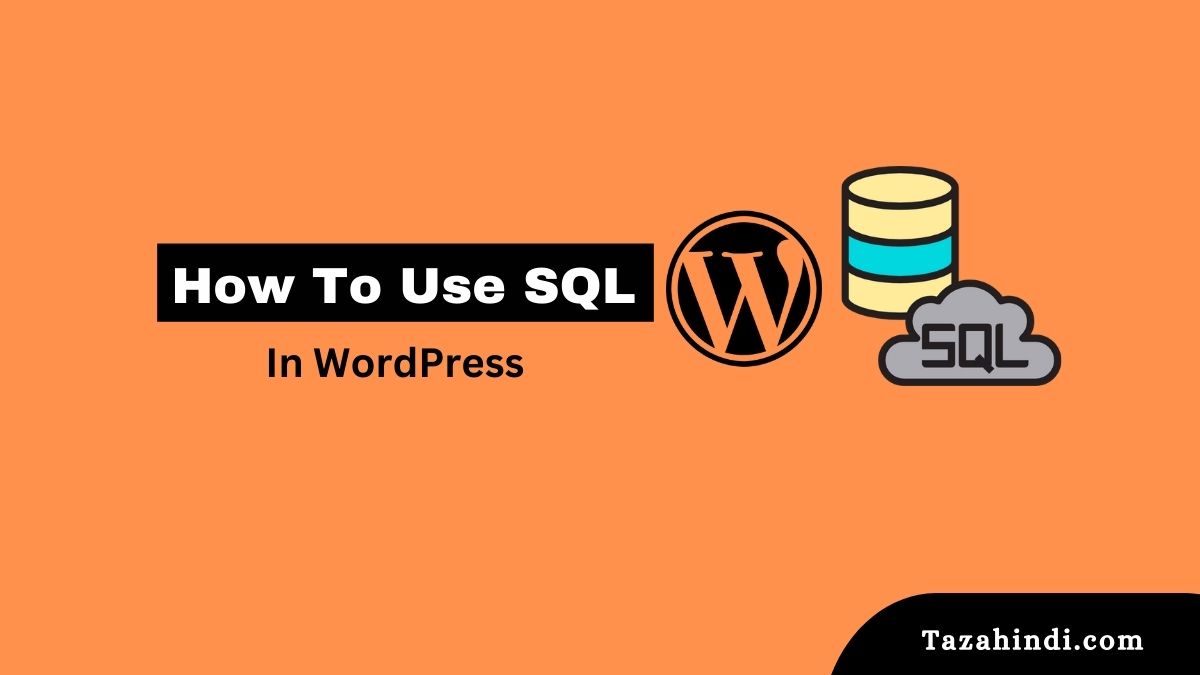How to Use SQL in WordPress: SQL is a programming language used to manage data in relational databases. It is used by developers, data analysts, and data scientists to manipulate and query data in a structured way. SQL is essential for managing data in web applications and content management systems like WordPress.
In this article I will cover the basics of using SQL in WordPress. I will teach you how to create, modify, and delete tables, insert and retrieve data from tables, and query data using SQL commands. Also cover some common SQL commands used in WordPress and answer frequently asked questions about using SQL in WordPress.
Why use SQL in WordPress?
By using SQL in WordPress, you can efficiently manage your data, retrieve it as needed, and modify it as necessary. Whether you’re building a small blog or a large-scale web application, SQL can help you manage and retrieve your data efficiently and effectively.
Here are some specific reasons why you might want to use SQL in WordPress:
- Flexibility: SQL allows you to perform complex queries on your database, giving you greater flexibility in managing and retrieving data.
- Efficiency: SQL is optimized for working with large datasets, which makes it a fast and efficient way to manage and retrieve data in WordPress.
- Scalability: As your website grows, so too will your data. SQL makes it easy to manage and scale your data as your website grows.
- Customization: By using SQL in WordPress, you have the ability to create custom queries and manage your data in a way that’s specific to your needs.
Step 1: Setting Up Your Database?
Before we start using SQL in WordPress, it’s important to understand the WordPress database.
What is WordPress Database?
WordPress uses MySQL as its database management system. The WordPress database contains several tables that store information about the website, including posts, pages, comments, and users.
How to create a new database in WordPress?
When you install WordPress, it automatically creates a database with a set of tables. These tables are identified by prefixes such as wp_, which are added to the beginning of each table name. You can access the WordPress database using a database management tool such as phpMyAdmin.
How to create tables in WordPress?
In SQL, tables are used to store data in a structured way. To create a table in WordPress, you need to use the SQL CREATE TABLE command. Here’s an example:
CREATE TABLE wp_mytable (
id INT(11) NOT NULL AUTO_INCREMENT,
name VARCHAR(50) NOT NULL,
email VARCHAR(50) NOT NULL,
PRIMARY KEY (id)
);
This command creates a table named wp_mytable with three columns: id, name, and email. The id column is set as an auto-incrementing integer, which means that each new row will be assigned a unique id. The name and email columns are set as non-null varchar fields, which means that they cannot be empty.
Also Read: How to Create Tables in SQL: A Beginner’s Guide
Step 2: Adding Data to Your Table
How to insert data into a table?
To insert data into a table in WordPress, you’ll need to use the SQL INSERT INTO command. Here’s the basic syntax for inserting data into a table:
INSERT INTO table_name (column1, column2, column3, ...)
VALUES (value1, value2, value3, ...);
Here’s an example of how you could insert a new row into a table called ‘wp_mytable’ with columns for ‘name’, ‘email’, and ‘phone’:
INSERT INTO wp_mytable (name, email, phone)
VALUES ('John Smith', 'john@example.com', '555-1234');
This command will insert a new row into the ‘wp_mytable’ table with values for the ‘name’, ‘email’, and ‘phone’ columns.
How retrieving data from a table?
To retrieve data from a table in WordPress, you’ll need to use the SQL SELECT command. Here’s the basic syntax for selecting data from a table:
SELECT column1, column2, ...
FROM table_name;
Here’s an example of how you could retrieve data from a table called ‘wp_mytable’:
SELECT name, email, phone
FROM wp_mytable;
This command will retrieve all rows from the ‘wp_mytable’ table, with values for the ‘name’, ‘email’, and ‘phone’ columns.
You can also use the WHERE clause to filter your results based on specific criteria. For example, to retrieve only the rows where the ‘phone’ column is equal to ‘555-1234’, you could use the following command:
SELECT name, email
FROM wp_mytable
WHERE phone = '555-1234';
This command will retrieve the ‘name’ and ‘email’ columns for rows where the ‘phone’ column is equal to ‘555-1234’.
Also Read: How to make money with Python programming
Step 3: Modifying Data in Your Table
How to modifying data in a table?
You can modify tables in WordPress using SQL commands. For example, you can add a new column to a table using the ALTER TABLE command:
ALTER TABLE wp_mytable ADD phone VARCHAR(20) NOT NULL;
This command adds a new column named phone to the wp_mytable table. The phone column is set as a non-null varchar field with a maximum length of 20 characters.
You can also modify existing columns using the ALTER TABLE command. For example, you can change the data type of a column:
ALTER TABLE wp_mytable MODIFY email TEXT NOT NULL;
This command changes the data type of the email column from varchar to text.
How to deleting data from a table?
To delete a table in WordPress, you can use the SQL DROP TABLE command:
DROP TABLE wp_mytable;
This command deletes the wp_mytable table from the WordPress database. Be careful when using this command, as it permanently deletes all data in the table.
How to insert data into a table?
To insert data into a table in WordPress, you can use the SQL INSERT INTO command. Here’s an example:
INSERT INTO wp_mytable (name, email, phone) VALUES
('John Smith', 'john@example.com', '555-1234'),
('Jane Doe', 'jane@example.com', '555-5678');
This command inserts two rows into the wp_mytable table. The rows contain values for the name, email, and phone columns.
How to retrieving data from a table?
To retrieve data from a table in WordPress, you can use the SQL SELECT command. Here’s an example:
SELECT * FROM wp_mytable;
This command retrieves all rows and columns from the wp_mytable table.
You can also retrieve specific rows and columns using the WHERE clause. For example:
SELECT name, email FROM wp_mytable WHERE phone='555-1234';
This command returns the name and email columns for rows where the phone column is equal to ‘555-1234’.
How to updating data in a table?
To update data in a table in WordPress, you can use the SQL UPDATE command. Here’s an example:
UPDATE wp_mytable SET email='newemail@example.com' WHERE name='John Smith';
This command updates the email column for the row where the name column is equal to ‘John Smith’.
How to deleting data from a table?
To delete data from a table in WordPress, you can use the SQL DELETE command. Here’s an example:
DELETE FROM wp_mytable WHERE name='Jane Doe';
This command deletes the row where the name column is equal to ‘Jane Doe’.
Common SQL Commands Used in WordPress
In addition to the basic SQL commands we’ve covered, there are several SQL commands that are commonly used in WordPress. These include:
- SELECT COUNT(*) FROM tablename: This command returns the total number of rows in a table.
- SELECT * FROM tablename LIMIT 10: This command returns the first 10 rows from a table.
- SELECT DISTINCT columnname FROM tablename: This command returns unique values for a column in a table.
- SELECT columnname FROM tablename ORDER BY columnname ASC: This command returns rows from a table sorted by a column in ascending order.
Also Read: How To Use SQL in Excel: A Step-by-Step Guide
Conclusion
In this beginner’s guide, we’ve covered the basics of using SQL in WordPress. We’ve learned how to create, modify, and delete tables, insert and retrieve data from tables, and query data using SQL commands. We’ve also covered some common SQL commands used in WordPress and answered frequently asked questions about using SQL in WordPress.
SQL is a powerful tool for managing data in WordPress, but it’s important to use it carefully and securely. By following best practices for SQL usage in WordPress, you can build powerful and secure web applications.
FAQs
-
What is SQL injection, and how can I prevent it in WordPress?
SQL injection is a type of security vulnerability where an attacker can inject malicious code into SQL statements. To prevent SQL injection in WordPress, you should use prepared statements or parameterized queries. These techniques allow you to separate the SQL code from the user input, preventing attackers from injecting malicious code.
-
Can I use SQL in WordPress plugins and themes?
Yes, you can use SQL in WordPress plugins and themes. However, you should be careful when using SQL in WordPress, as it can have security implications. Always validate user input and use prepared statements or parameterized queries to prevent SQL injection.
-
How can I optimize SQL queries in WordPress?
To optimize SQL queries in WordPress, you should use indexes on columns that are frequently queried. You can also use caching plugins to reduce the number of SQL queries that are executed on each page load.



